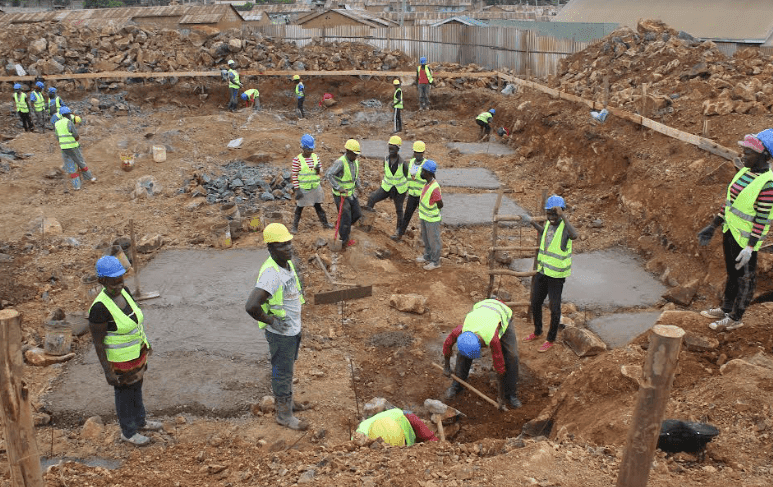Loading News Article...
We're loading the full news article for you. This includes the article content, images, author information, and related articles.
We're loading the full news article for you. This includes the article content, images, author information, and related articles.
Kenya faces a significant housing deficit, with annual demand far outstripping supply, making homeownership a distant dream for many. The government's ambitious affordable housing agenda aims to bridge this gap, but faces hurdles including funding and land acquisition.

Kenya is grappling with a severe housing deficit, particularly in its rapidly expanding urban centres. The country faces an annual housing demand of 250,000 units, yet only an estimated 50,000 units are supplied, resulting in a cumulative deficit of over 2 million homes. This shortfall is exacerbated by a high urbanisation rate of 4.4% annually, translating to approximately 500,000 new city dwellers each year. The scarcity of affordable and decent housing means that a significant portion of the urban population, estimated at 46.5%, resides in informal settlements.
In response to this critical challenge, the Kenyan government has prioritised affordable housing as a key pillar of its development agenda. The Affordable Housing Programme (AHP), initially launched under the Big Four Agenda in 2018, aimed to deliver 500,000 affordable housing units by 2022. While this target faced challenges, the government, under the Bottom-Up Economic Transformation Agenda (BETA), has renewed its commitment to facilitating the delivery of 250,000 houses annually.
Key policy reforms have been introduced to streamline the AHP. The Affordable Housing Act, 2024, established an affordable housing levy of 1.5% on gross salary for employees, with a matching employer contribution, and a similar rate for those in business. Furthermore, the Affordable Housing Regulations, 2024, approved by the Cabinet, reduced the housing deposit requirement from 10% to 5%, aiming to lower the barrier to entry for aspiring homeowners. These regulations also provide for equitable housing allocation and access to low-interest or low-monthly-payment home loans.
The government actively encourages public-private partnerships (PPPs) to accelerate the delivery of affordable housing, offering incentives such as tax breaks and simplified regulatory processes for private developers. The Kenya Mortgage Refinance Company (KMRC) plays a crucial role by providing long-term, low-interest funds to mortgage lenders, making home loans more accessible.
Despite these efforts, challenges persist. Florence Eshalomi, a Labour chair of the housing select committee, emphasised that solving the housing crisis requires not just building more homes, but ensuring their affordability. She noted that developers often prioritise profitable luxury units over housing that meets the needs of local people. Stella Creasy, a Labour MP, highlighted the impact of development on existing communities, citing rising rents and gentrification as contributors to high poverty levels.
Source: Habitat for Humanity, Centum Real Estate, BuyRentKenya, KIPPRA, CAHF, KNBS, Ministry of Lands, Public Works, Housing and Urban Development. Dates vary by statistic.
The persistent housing deficit has significant socio-economic implications. The high cost of land, particularly in urban areas, and expensive building materials are major contributors to the unaffordability of housing. Limited access to long-term, affordable mortgages, especially for those in informal employment, further exacerbates the problem. The proposal in the Finance Bill 2025 to remove VAT exemptions on building materials could potentially increase construction costs and slow down housing delivery.
Furthermore, rapid urbanisation without adequate planning has led to the proliferation of informal settlements, characterised by poor quality housing, inadequate infrastructure, and a lack of basic services. This unchecked growth increases the cost of transport and public infrastructure, consumes prime farmland, and contributes to environmental degradation.
While the government aims to construct 250,000 units annually, the actual delivery has faced hurdles. As of April 2025, approximately 140,000 units had been completed, with a recent release of 5,000 units attracting over 500,000 applicants through the Boma Yangu platform. However, legal disputes have delayed occupancy timelines, shifting the initial move-in target from December 2024 to April 2025. Some public-private partnerships have also encountered resistance from local communities due to concerns over displacement and inadequate compensation.
The Affordable Housing Regulations, 2025, approved by the National Assembly on Thursday, August 14, 2025, aim to further streamline the project by reducing deposit requirements and providing clear criteria for qualification and allocation. The government is also exploring innovative solutions such as low-cost construction technologies and rent-to-own financing models to enhance affordability.
The effectiveness of the reduced deposit requirement and the new allocation criteria will be crucial in determining the programme's success. Observers will also be keenly watching the impact of the proposed changes in the Finance Bill 2025 on construction costs and the overall pace of housing delivery. Continued collaboration between the government, private developers, and communities will be essential to overcome existing challenges and ensure that more Kenyans can access decent and affordable homes.
Keep the conversation in one place—threads here stay linked to the story and in the forums.
Other hot threads
E-sports and Gaming Community in Kenya
Active 6 months ago
Popular Recreational Activities Across Counties
Active 6 months ago
The Role of Technology in Modern Agriculture (AgriTech)
Active 6 months ago
Investing in Youth Sports Development Programs
Active 6 months ago